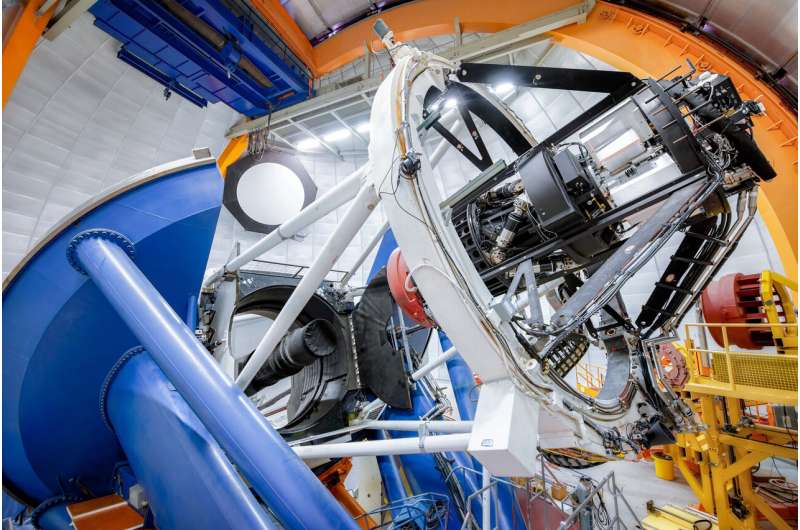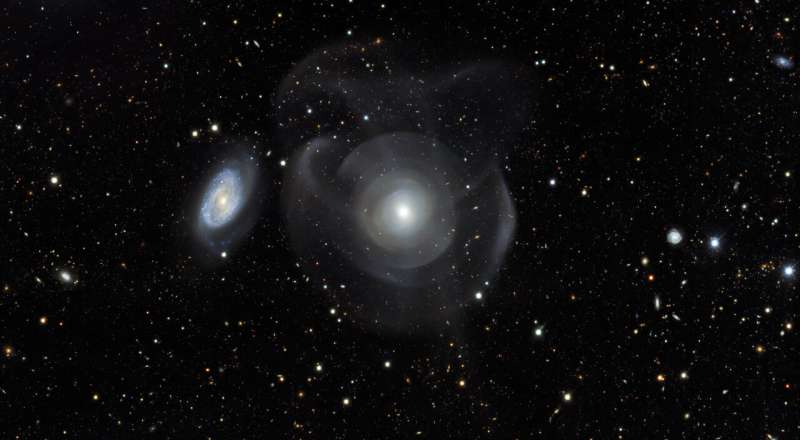The Dark Energy Survey has released a massive, public collection of astronomical data and calibrated images from six years of work. Containing data on nearly 700 million astronomical objects, this second data release in the Survey's seven-year history is the topic of sessions today and tomorrow at the 237th Meeting of the American Astronomical Society.
DR2 is the second release of images and object catalogs from the Dark Energy Survey (DES). It is the culmination of over a half-decade of astronomical data collection and analysis, with the ultimate goal of understanding the accelerating expansion rate of the universe and the phenomenon of dark energy that is thought to be responsible for the expansion. The Dark Energy Survey is a global collaboration that includes Fermi National Accelerator Laboratory (Fermilab), National Center for Supercomputing Applications (NCSA), and NSF's NOIRLab.
Including a catalog of nearly 700 million astronomical objects, DR2 builds on the 400 million objects cataloged with the survey's previous data release (DR1), and also improves on it by refining calibration techniques, which, with the deeper combined images from DR2, leads to improved estimates of the amount and distribution of matter in the universe. It is one of the largest astronomical catalogs released to date.
Astronomical researchers around the world can access these unprecedented data and mine them to make new discoveries about the universe, complementary to the studies being carried out by the Dark Energy Survey collaboration. The full data release can be accessed here and is available to scientists and the public to explore.
One early result relates to the construction of a catalog of RR Lyrae pulsating stars, which tell scientists about the region of space beyond the edge of our Milky Way. In this area nearly devoid of stars, the motion of the RR Lyrae stars hints at the presence of an enormous halo of invisible dark matter, which may provide clues to how our galaxy evolved over the last 12 billion years. In another result, DES scientists used the extensive DR2 galaxy catalog, along with data from the LIGO gravitational wave experiment, to estimate the location of a black hole merger and, independent of other techniques, infer the value of the Hubble constant, a key cosmological parameter. Combining their data with other surveys, DES scientists have also been able to generate a detailed map of the Milky Way's dwarf satellites, giving researchers insight into how our own galaxy was assembled and how it compares with cosmologists' predictions.
The detailed precision cosmology constraints based on the full six-year DES data set will come out over the next two years.

DES was conceived to map hundreds of millions of galaxies and to chart the size of the expanding universe as it accelerates under the influence of dark energy. DES has produced the largest and most accurate dark matter map from galaxy weak lensing to date.
Covering 5000 square degrees of the southern sky, the survey data enable many other investigations in addition to those targeting dark energy, covering a vast range of cosmic distances—from discovering new nearby solar system objects to investigating the nature of the first star-forming galaxies in the early universe.
"This is a momentous milestone. For six years, the Dark Energy Survey collaboration took pictures of distant celestial objects in the night sky. Now, after carefully checking the quality and calibration of the images captured by the Dark Energy Camera, we are releasing this second batch of data to the public," said DES Director Rich Kron of Fermilab and the University of Chicago. "We invite professional and amateur scientists alike to dig into what we consider a rich mine of gems waiting to be discovered."
The primary tool used to collect these images, the Dark Energy Camera (DECam), is mounted on the National Science Foundation-funded Víctor M. Blanco 4-meter Telescope, part of the Cerro Tololo Inter-American Observatory (CTIO) in the Chilean Andes, a Program of NSF's NOIRLab. Each week from 2013 to 2019, DECam collected thousands of images of the southern sky, unlocking a trove of potential cosmological insights.
Once captured, these images (and the large amount of data surrounding them) were transferred to NCSA for processing via the DES Data Management (DESDM) project. Using the Blue Waters supercomputer at NCSA, the Illinois Campus Cluster, and computational systems at Fermilab, NCSA prepares calibrated data products for research and public consumption. It took approximately four months to process one year's worth of data into a searchable, usable catalog. The DES DR2 is hosted at the Community Science and Data Center (CSDC), a Program of NSF's NOIRLab. CSDC provides software systems, user services, and development initiatives to connect and support the scientific missions of NOIRLab's telescopes, including the Blanco Telescope at CTIO.
"Because astronomical data sets today are so vast, the cost of handling them is prohibitive for individual researchers or most organizations," said Robert Nikutta, Project Scientist for Astro Data Lab at CSDC. "CSDC provides open access to big astronomical datasets like DES DR2, and the necessary tools to explore and exploit them—then all it takes is someone from the community with a clever idea to discover new and exciting science."



